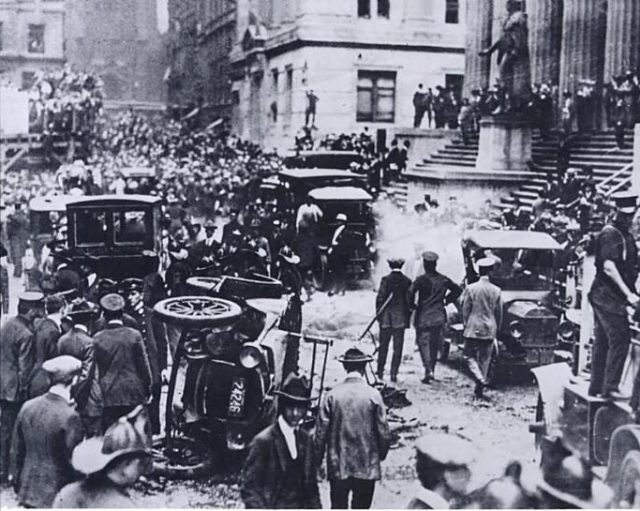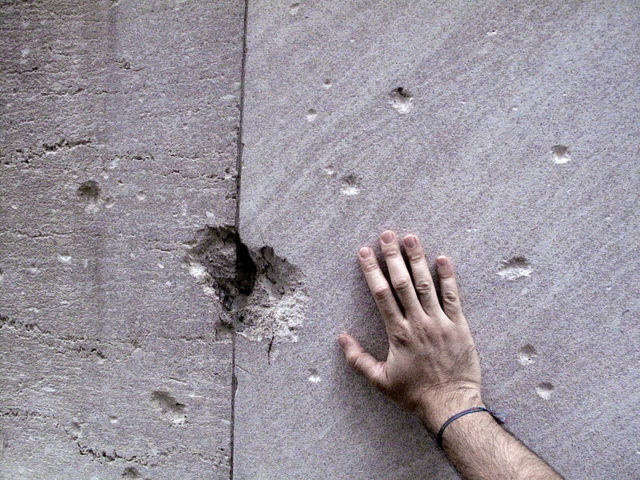When one thinks about deadly attacks on the United States, the first thing that comes to mind is usually the 9/11 assault on the Twin Towers in New York City and the Pentagon in Washington, D.C.
Another well-known incident is the attack on Pearl Harbor by Japanese forces in December 1941. Some people are also reminded of the bombing of the World Trade Center in 1993 by Al-Qaeda. In fact, according to johnstonsarchive.net, terrorist activities have plagued the United States since 1886, when someone threw a bomb into a crowded labor rally in Chicago’s Haymarket Square.

One deadly attack, not as widely discussed, occurred in New York City’s financial district in 1920. On Sept. 16, Wall Street was bustling with activity; the New York Stock Exchange, the offices of J.P. Morgan and Company, and the U.S. Sub-Treasury and Assay Office were all within a few blocks of each other. At noon, the Trinity Church bells rang out the hour, only to be interrupted by the explosion of 100 pounds of dynamite mixed with 500 pounds of iron. The explosive had been left in a horse-drawn wagon in front of the Assay Office and directly across the street from Morgan’s offices. The iron turned into hundreds of daggers flying through the air.
William H. Remick, president of the New York Stock Exchange, immediately halted trading to avoid a panic. Most of the 38 people who were killed died immediately. The majority of the victims were messengers, secretaries, and clerks on their lunch break. There was also more than $2 million in damages, including the gutting of most of the Morgan building’s interior.

At first, the Justice Department’s Bureau of Investigation considered it an accident. Later that day, the Board of Governors of the New York Stock Exchange announced they would conduct business as usual the next day. Overnight, crews cleaned up the broken window glass, blood, and the broken and burnt bodies of the victims, but in their haste they may have destroyed critical evidence.
Investigators soon turned their focus to radical groups that were openly critical of U.S. government policies. In its report on the bombing, the Washington Post called it an “act of war.”
The attack renewed efforts by police and federal detectives to track the activities of foreign radicals. In an effort to capture the guilty parties, the General Intelligence Division, headed by J. Edgar Hoover, was called upon to help in the investigation. The NYPD enlisted a force of secret police to observe “radicals” known to be currently in the city.
Professional tennis player Edwin Fischer had sent warning messages to friends alerting them to stay away from the financial district that day. When he was questioned by authorities, Fischer told them he had received the information from God. After some investigation, it was discovered that Fischer was suffering from mental illness and had done this type of thing before. He was judged not to have been associated in any way with the bombing and was taken to a local mental institution.
The bombing investigations were carried out for over three years, with little success. Minor arrests were made, but all failed to uncover the instigators. The new Federal Bureau of Investigation, which replaced the Justice Department’s Bureau of Investigation, continued the search. After ruling out radical and communist groups, they determined the explosion was the work of Italian terrorists.
Some historians believe Italian anarchist Mario Buda was the person who supplied the bomb, in retaliation for the imprisonment of his comrades–anarchists Nicola Sacco and Bartolomeo Vanzetti. Buda had experience with explosives and had previously used iron as shrapnel.

He was also a suspect in a 1917 bombing responsible for the deaths of several policemen in Milwaukee, Wisconsin. Although Buda was in New York City on the day of the bombing, he was not questioned by police or investigators. In November, Buda returned to Italy permanently.
Read another story from us: The firebombing of Tokyo was the single deadliest air raid in history
There is still evidence of the bombing on the marble exterior of the Morgan building. Shrapnel made pockmarks on the walls, some of which are as large as a man’s hand.
